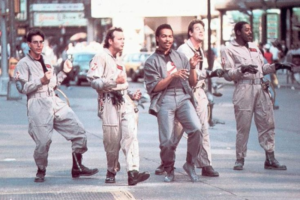Business Development
Ghostbusters: Tips for Dealing With Non-Responsive Prospective Clients
- BY John Reed
Pursuing a prospective client is like trick-or-treating on Halloween. You might bring in new business equivalent to a Super King pack of four Reese's Peanut Butter Cups (a major score). Or, despite seeing the house lights on and a car in the driveway, you might ring the doorbell multiple times and come away empty.
Courting a new client can take a lot of effort—even after an encouraging initial meeting or two.
Courting a new client can take a lot of effort. Did you know half of legal services buyers choose the lawyer who reaches out or responds to them first? Those sound like great odds. But don’t assume you’ll match with the prospect’s precise legal need on the first outreach attempt. After all, the house giving out that big sleeve of Reese’s may be the last one you visit, or maybe it’s the homeowner who hears the seventh or eighth doorbell ring and comes to the door during a commercial break while watching a wildly successful 1984 comedy-horror film.
What do you do when the prospect goes dark (as in non-responsive, not Satanic) and ghosts you? Grab your proton pack, fire up your particle thrower, and follow these tips.
“There is no Dana. Only Zuul.”

Don’t try to push your way past them. That will only cement your place on their bad side. Instead, woo the gatekeeper like you court the prospect. There is no sweeter sound than the reverberation of one’s own name, so if you know the name of the executive assistant, office manager, spouse, or family member who’s impeding your progress, use it, even if they go by Zuul. Make small talk, ask questions about them, and find out how they want you to treat them. You can use what you learn in later phone calls or emails to show you’re worthy of their business.
“May I see this storage facility?”
The pandemic has made many people lazy and Zoom-crazy. Why meet in person when email, voicemail, text, and videoconferencing are more convenient?
Virtually every lawyer I’ve ever coached has told me how effective they are one-on-one, sitting across the table from a prospective client. It’s getting a prospect to the table that’s the hard part.
One of the most efficient, effective ways to launch the relationship forward is to visit the prospect where they work or live. If they are a general counsel, offer to bring bagels and fruit to their office for a quick morning meeting. If they’re a real estate developer, see if you can tour a construction site. If the person you hope to represent has a divorce or personal injury claim, offer to meet at their home or while they walk the dog.
I once met with a general counsel in his office at a Fortune 500 manufacturing company. Our legal discussion only took a few minutes, but he then took me on a tour of the world-class artwork the founder collected and displayed throughout the corporate headquarters. He was proud of his workplace and happy to share his knowledge of each piece, and I enjoyed the museum-like experience.

“Maybe if we start dancing, other people will join in?”
I’ve written about this before. “Just Following Up” is a terrible way to follow up.
Suppose you’ve presented a proposal at the prospect’s request but haven’t heard back. Maybe you sent an engagement letter after a free consultation, and you’re waiting for a signature. Perhaps you received a referral from another attorney and had a great first conversation with the person, but got no reply after leaving them a voicemail. In these situations, most lawyers will then check in, circle back, and gently nudge. Following up once to ensure they received your proposal, letter, or message is acceptable, but when you launch a series of reminders, you’re an annoying pest. Here’s why.

If I’m the prospect, your badgering shows a singular interest in getting my money. To me, you are one-dimensional, and if this is how you treat your clients, I’m out.
I have a mantra for you to chant: Demonstrate what it's like to work with you.
Think about what you do for current clients. You may send them updates about new laws and opinions affecting their case or an article that triggered your memory of an earlier conversation. You might introduce them to a consultant or vendor who could improve the prospect’s business. When an important date like a birthday, wedding, child’s graduation, or family trip nears, you may wish them well or congratulate them. That’s how you show your clients you care.
Why wouldn’t you do the same for a soon-to-be client? You want to have that same working relationship with them, right? The only difference is that the prospect hasn’t formally retained you yet. When you stop bugging me and start relating to me, you’re reminding me why I was interested in hiring you originally.
Maybe by finding other ways to connect with your prospect, they will be more willing to move forward.
“Human sacrifice! Dogs and cats living together! Mass hysteria!”

While pursuing the prospect, something pressing may arise that they need to know and for which they should take immediate action. Think statute of limitations, end of the fiscal year, preservation of evidence, or any number of unforeseen issues.
Harkening back to our mantra, appropriately advising clients of risks that affect their matters is part of your job as an attorney and counselor. Again, for business development purposes, the only difference between a client and a prospect is a signature on a page.
Consider what would happen if you didn’t bring the risk to their attention with a sense of urgency. Malpractice and a grievance may be safely off the table, but they could resent you, lose any trust they had in you, and badmouth you to colleagues and friends. Who they gonna call? Not you.
“I have a radical idea. We cross the streams.” (or “If you’re all alone, pick up the phone.”)
I recently had dinner with Laura Khalil of Brave By Design. Laura is a badass businessperson, trusted advisor, friend, and catalyst for launching my Sticky Lawyers Podcast. During our conversation, we compared notes about what to do when a prospective client continually ghosts you. We each had a different answer.
Laura’s suggestion was pretty much “sh*t or get off the pot.” Say you presented the prospect with a proposal, and it’s been languishing for some time. If crickets still chirp and tumbleweeds roll by after multiple attempts (including messages like those in the two previous sections), fire off an email with one concise question.
“Are we done here?”
One could interpret this as, “You’ve yanked my chain enough, so I’ll be the adult in the room and ask if you’re no longer interested in working with me,” or “I take it you found my proposal and what I’m offering to be exactly what you want at the right price, and all that’s needed is your approval to get started.” The question is brilliant in its simplicity.
My approach is a bit more dramatic and uses self-deprecation and human behavior. To elicit a reply to that as-yet unanswered proposal, I suggest calling the prospect and saying directly if they answer or via voicemail if they don’t:
“I don’t know what I did to offend you, but apparently, it was something that caused you not to get back to me. Whatever it was, I apologize, and I hope to have the chance to discuss it.”
As I said, it’s dramatic, maybe even melodramatic. You (hopefully) did nothing wrong. But in the remote chance you ticked them off somehow, you’re being the bigger person and owning up to the transgression you didn’t know you committed. Human nature dictates that the prospect will feel bad for causing you to think you’ve upset them. They’ll be motivated to reply, putting your worrying mind to rest and maybe sealing the deal, too.
“Ray, when someone asks you if you’re a God, you say yes!”
I know it feels awkward to say you’re “pursuing” a client. The truth is, if you don’t take charge with non-responders, the engagement probably won’t happen.

If you’ve got a hot prospect on the line, assume you have the relationship until you don’t and act accordingly.
Now get out there and find yourself a Reese’s Super King!






